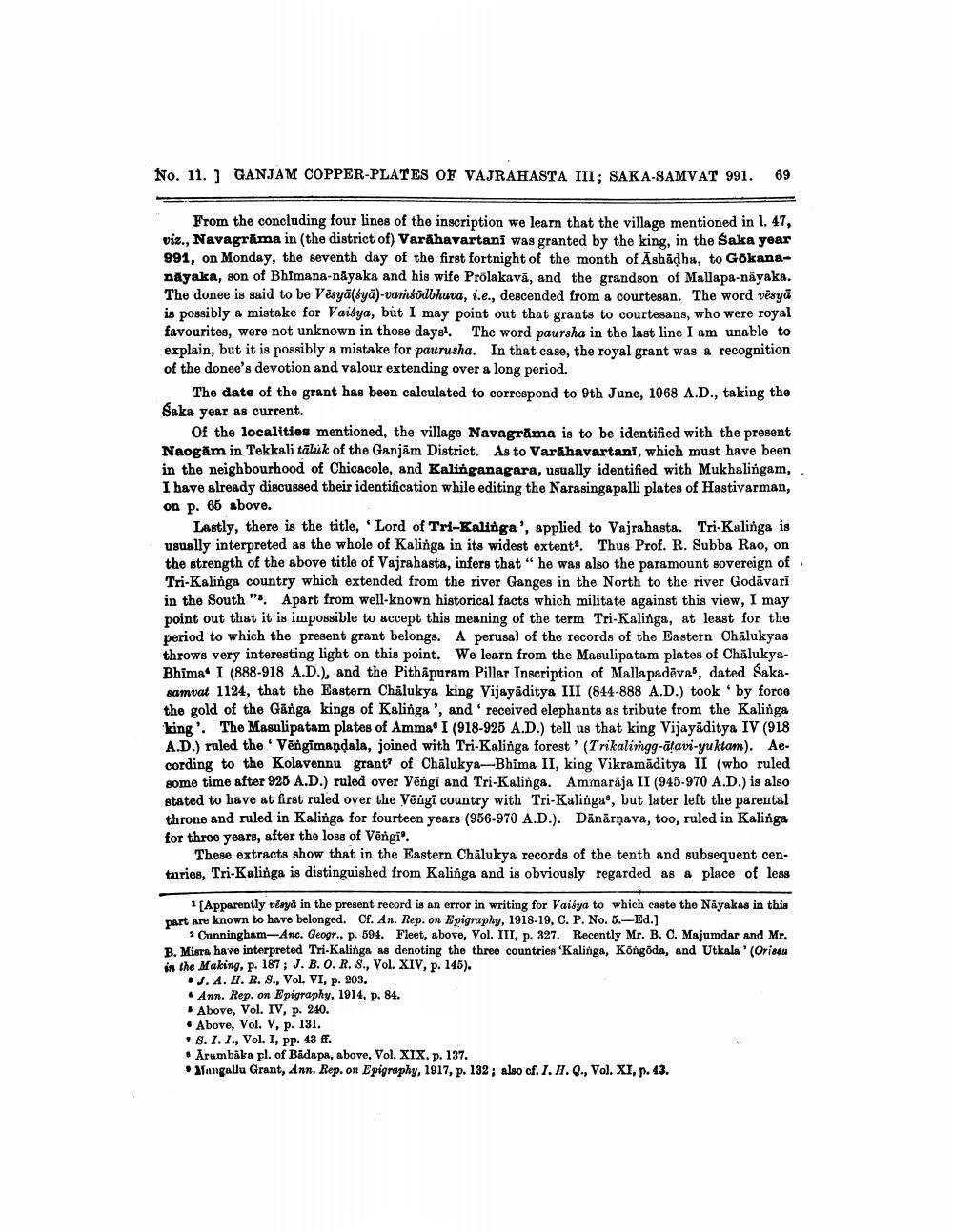________________
No. 11. ] GANJAM COPPER-PLATES OF VAJRAHASTA III; SAKA-SAMVAT 991. 69
From the concluding four lines of the inscription we learn that the village mentioned in l. 47, viz., Navagrāma in (the district of) Varāhavartani was granted by the king, in the Saka year 991, on Monday, the seventh day of the first fortnight of the month of Ashādha, to Gokananāyaka, son of Bhimana-nayaka and his wife Prõlakavā, and the grandson of Mallapa-näyaka. The donee is said to be Vēsyä(tyä)-varsodbhava, i.e., descended from a courtesan. The word vēsyā is possibly a mistake for Vaisya, but I may point out that grants to courtesans, who were royal favourites, were not unknown in those days. The word paursha in the last line I am unable to explain, but it is possibly a mistake for paurusha. In that case, the royal grant was a recognition of the donee's devotion and valour extending over a long period.
The date of the grant has been calculated to correspond to 9th June, 1068 A.D., taking the Saka year as current.
Of the localities mentioned, the village Navagrama is to be identified with the present Naogām in Tekkali tāluk of the Ganjām District. As to Varahavartani, which must have been in the neighbourhood of Chicacole, and Kalinganagara, usually identified with Mukhalingam, I have already discussed their identification while editing the Narasingapalli plates of Hastivarman, on p. 65 above.
Lastly, there is the title, 'Lord of Tri-Kalinga', applied to Vajrahasta. Tri-Kalinga is usually interpreted as the whole of Kalinga in its widest extent. Thus Prof. R. Subba Rao, on the strength of the above title of Vajrahasta, infers that he was also the paramount sovereign of Tri-Kalinga country which extended from the river Ganges in the North to the river Godāvari in the South "s. Apart from well-known historical facts which militate against this view, I may point out that it is impossible to accept this meaning of the term Tri-Kalinga, at least for the period to which the present grant belongs. A perusa) of the records of the Eastern Chālukyas throws very interesting light on this point. We learn from the Masulipatam plates of Chāluky&Bhima I (888-918 A.D.), and the Pithapuram Pillar Inscription of Malla padēva', dated Sakasamvat 1124, that the Eastern Chalukya king Vijayāditya III (844-888 A.D.) took by force the gold of the Ganga kings of Kalinga', and received elephants as tribute from the Kalinga king'. The Masulipatam plates of Amma I (918-925 A.D.) tell us that king Vijayāditya IV (918 A.D.) ruled the 'Vēngimaņdala, joined with Tri-Kalinga forest' (Trikalingg-ātavi-yuktam). Aecording to the Kolavennu grant of Chalukya-Bhima II, king Vikramāditya II (who ruled some time after 925 A.D.) ruled over Vēngi and Tri-Kalinga. Ammarāja II (945-970 A.D.) is also stated to have at first ruled over the Véngi country with Tri-Kalinga, but later left the parental throne and ruled in Kalinga for fourteen years (956-970 A.D.). Dānārņava, too, ruled in Kalinga for three years, after the loss of Vëngi'.
These extracts show that in the Eastern Chālukya records of the tenth and subsequent centuries, Tri-Kalinga is distinguished from Kalinga and is obviously regarded as a place of less
1[Apparently vēsyā in the present record is an error in writing for Vaisya to which caste the Nāyakas in this part are known to have belonged. Cf. An. Rep. on Epigraphy, 1918-19, C. P. No. 5.-Ed.)
+ Cunningham-Anc. Geogr., p. 594. Fleet, above, Vol. III, p. 327. Recently Mr. B. C. Majumdar and Mr. B. Misra have interpreted Tri-Kalinga as denoting the three countries 'Kalinga, Kongõda, and Utkala '(Orissu in the Making, p. 187; J. B. O. R. S., Vol. XIV, p. 145).
.J.A. H. R. S., Vol. VI, p. 203. . Ann. Rep. on Epigraphy, 1914, p. 84.
Above, Vol. IV, p. 240. • Above, Vol. V, p. 131.
8.1. I., Vol. I, pp. 43 ff. • Arumbāka pl. of Bädapa, above, Vol. XIX, p. 137.
langallu Grant, Ann. Rep. on Epigraphy, 1917, p. 132 ; also cf. 1. 7. Q., Vol. XI, p. 43.




